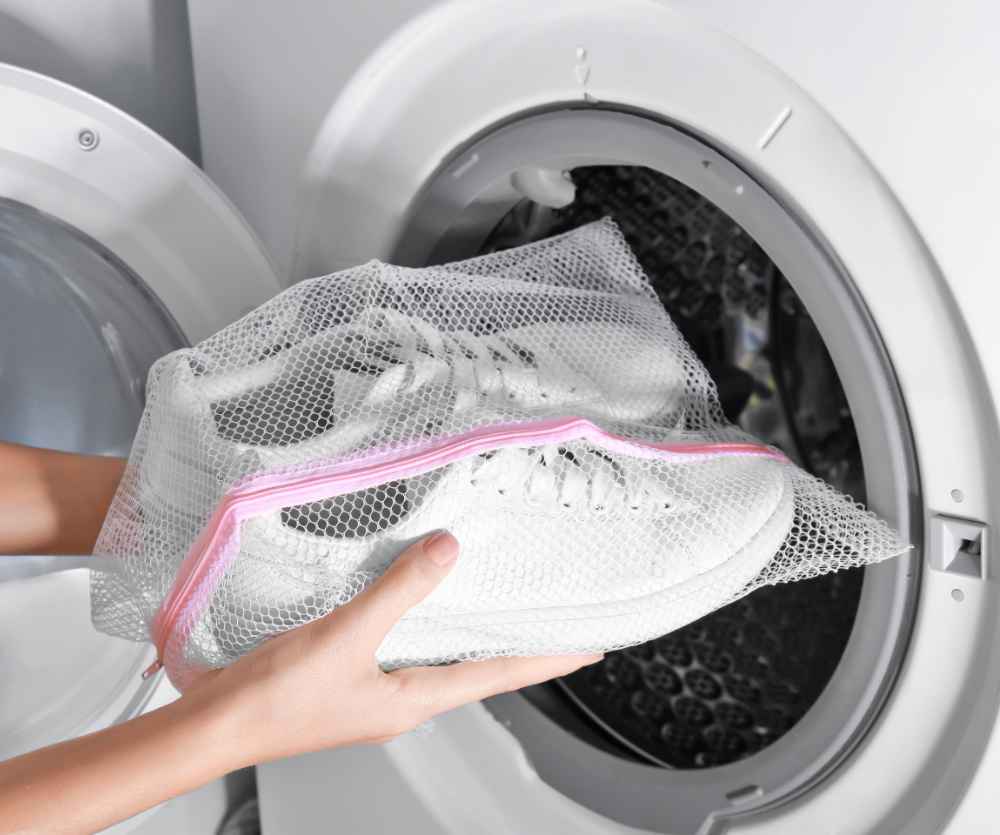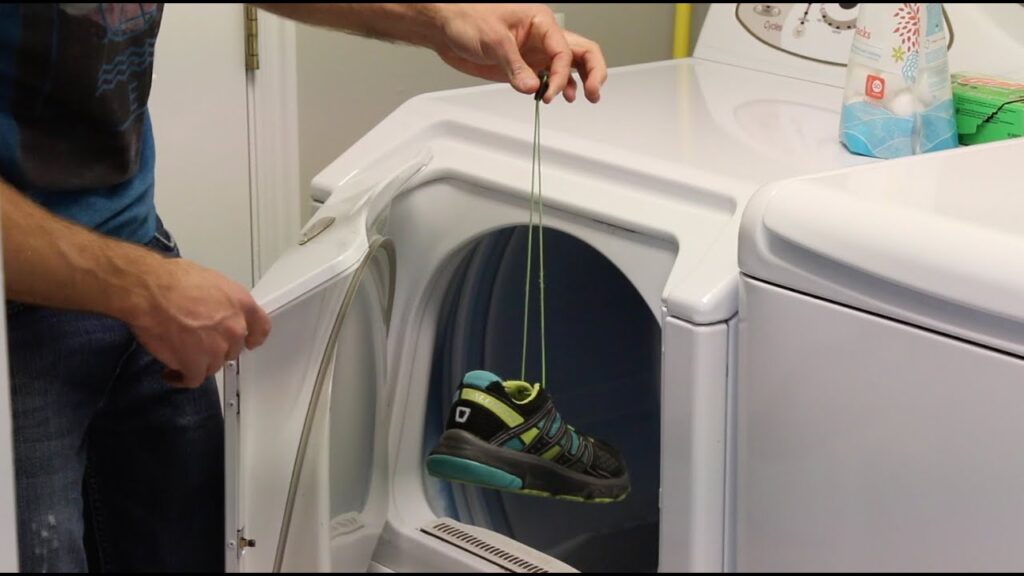The sudden downpour catches you off guard, or perhaps an unexpected puddle turns your morning jog into a soggy ordeal. Now your favorite pair of sneakers, the ones that fit just right and offer perfect support, are soaked. Or maybe it’s a pair of kids’ shoes, urgently needed for tomorrow’s school trip. The immediate thought that springs to mind for many is the quick fix: the clothes dryer. It’s a powerful appliance designed to rapidly remove moisture, so why not shoes?
This seemingly simple question, “Can you put shoes in the dryer?”, opens up a complex discussion fraught with potential pitfalls and surprising exceptions. On one hand, the appeal of a fast solution is undeniable. Waiting for shoes to air dry can take a day or two, sometimes longer depending on humidity and material, leading to discomfort, inconvenience, and even the growth of mildew and bacteria. The dryer promises a speedy return to dry comfort.

However, the convenience often comes at a steep price. Footwear is a sophisticated blend of various materials – adhesives, foams, rubbers, plastics, leather, suede, and textiles – each reacting differently to intense heat and vigorous tumbling. What might be a harmless spin for a cotton t-shirt can be a death sentence for a carefully constructed running shoe, leading to irreparable damage, shrinkage, deformation, or even complete structural breakdown. Understanding these material sensitivities is crucial to preserving your investment and avoiding costly mistakes.
This comprehensive guide delves deep into the science and practicalities of drying shoes. We will explore the inherent risks associated with dryer use, examine safer alternatives, and, for those truly desperate situations, outline specific methods to minimize damage if the dryer is your only option. Our aim is to equip you with the knowledge to make informed decisions, ensuring your footwear remains functional, comfortable, and aesthetically pleasing for as long as possible, saving you from the frustration of prematurely ruined shoes and the unnecessary expense of frequent replacements.
The Dryer Dilemma: Risks and Rewards of Rapid Drying
The allure of the clothes dryer for wet shoes is powerful, primarily driven by its unparalleled speed. In a world where time is often of the essence, the prospect of taking a pair of sodden sneakers and having them ready to wear in an hour or less is incredibly tempting. This rapid drying can also be beneficial in preventing the growth of odor-causing bacteria and mildew, which thrive in damp environments. However, these perceived rewards are often outweighed by significant risks, particularly when considering the diverse materials and intricate construction of modern footwear.
The primary concern when exposing shoes to a dryer is the combination of intense heat and mechanical tumbling. Unlike clothing, which is typically designed to withstand such conditions, shoes are engineered for specific functions, often relying on a delicate balance of flexible and rigid components, precise stitching, and temperature-sensitive adhesives. The heat generated by a typical clothes dryer can easily exceed the tolerance levels of these materials, leading to a cascade of problems that compromise the shoe’s integrity, comfort, and lifespan. For instance, the EVA foam commonly found in sneaker midsoles, crucial for cushioning and support, can become brittle or shrink unevenly under high heat, fundamentally altering the shoe’s performance. Similarly, the thermoplastic polyurethane (TPU) elements used for stability and structure can warp or melt.
Understanding the Heat Factor
Heat is the silent destroyer of shoes in a dryer. Most household dryers operate at temperatures ranging from 120°F (49°C) on a low setting to over 160°F (71°C) on high. While these temperatures are effective for drying fabrics, they are often detrimental to the complex materials found in shoes. Adhesives, which bond various parts of the shoe together, are particularly vulnerable. Many modern shoes use water-based or solvent-based glues that can soften, weaken, or even completely fail when exposed to prolonged high heat. This can lead to soles detaching, seams coming apart, and decorative elements falling off, effectively rendering the shoe unusable.
Beyond adhesives, various shoe materials react differently to heat:
- Leather and Suede: These natural materials are highly susceptible to heat-induced damage. High temperatures can cause them to dry out rapidly, becoming stiff, brittle, and prone to cracking. Leather can also shrink significantly and lose its natural oils, leading to a dull appearance and reduced durability.
- Synthetics (Polyester, Nylon, Spandex): While some synthetics are more heat-resistant than natural fibers, prolonged exposure to high temperatures can still cause them to melt, warp, or lose their shape. This is particularly true for mesh uppers and synthetic overlays designed for breathability and support.
- Rubber and Foam: Soles made of rubber can become hard and less flexible, losing their grip and cushioning properties. Foam components, like those in insoles and midsoles, can shrink, deform, or even crumble, leading to a loss of comfort and support.
- Plastics and PVC: Many shoe components, from eyelets to structural supports, are made of various plastics. These can easily warp, melt, or become brittle under dryer heat, compromising the shoe’s structure.
The Impact of Tumbling and Agitation
Aside from heat, the mechanical action of tumbling inside a dryer poses another significant threat. Shoes are not designed to be violently tossed around in a drum. The repeated impact against the dryer walls and other shoes or items can cause physical damage, such as scuffs, tears, and structural deformation. Delicate embellishments, laces, and even the overall shape of the shoe can be compromised. This is particularly true for shoes with intricate designs, delicate stitching, or prominent branding that can be rubbed off or damaged by friction.
Moreover, the constant banging can be incredibly noisy, rattling your entire household and potentially causing damage to the dryer itself. The impact can stress the dryer’s drum bearings and other internal components over time, leading to premature wear and tear on the appliance. Therefore, even if you manage to avoid heat damage, the physical trauma of tumbling can still significantly shorten the lifespan of your footwear and potentially your dryer.
Material Compatibility with Dryer Heat
To illustrate the varying sensitivities, consider the following table:
| Material Type | Heat Damage Risk | Shrinkage Risk | Adhesion Issues | Structural Deformation | Dryer Compatibility (General) |
|---|---|---|---|---|---|
| Canvas/Cotton | Moderate (fading, slight stiffness) | Moderate to High | Low to Moderate | Low | Caution (low/no heat) |
| Synthetic Mesh/Nylon | High (melting, warping) | Low | Moderate to High | High | No |
| Leather/Suede | Very High (cracking, brittleness) | Very High | Moderate | High | No |
| Rubber Soles | Moderate (hardening, cracking) | Low | High (detachment) | Moderate | No |
| EVA/Foam Midsoles | Very High (shrinking, crumbling) | Very High | N/A | Very High | No |
As the table clearly shows, the vast majority of shoe materials are not designed to withstand the high temperatures and mechanical stress of a clothes dryer. The short-term convenience of rapid drying almost always comes at the expense of your shoe’s longevity, comfort, and structural integrity. In most cases, the financial cost of replacing a ruined pair of shoes far outweighs the benefit of a few hours saved in drying time. Therefore, while the dryer might offer a tempting quick fix, it is generally a method to be avoided for preserving your footwear investment.
Beyond the Tumbler: Safer Drying Methods for Every Shoe Type
Given the significant risks associated with using a clothes dryer for shoes, exploring and adopting safer, more effective drying methods is paramount. These alternatives prioritize the preservation of your shoe’s materials, structure, and overall lifespan, ensuring they remain comfortable and functional for years to come. While they may require a bit more patience than the instant gratification of a dryer, the long-term benefits in terms of shoe longevity and performance are invaluable.
Air Drying: The Gold Standard for Shoe Care
Air drying is universally recognized as the safest and most recommended method for drying almost any type of footwear. It involves allowing shoes to dry naturally at room temperature, ideally with good air circulation. This gentle process prevents the material damage, shrinkage, and adhesive failure that high heat can cause. While it takes longer, typically 12 to 48 hours depending on the shoe material, thickness, and ambient humidity, it is the least destructive option. To optimize air drying and prevent mildew or odors, several steps should be followed:
- Initial Cleaning: Before drying, clean any visible dirt or mud from the exterior of the shoes. This prevents dirt from setting into the fabric as it dries and helps prevent odors.
- Remove Insoles and Laces: Take out the insoles and laces. This allows for better airflow inside the shoe and ensures that these often thicker components dry thoroughly. Insoles, in particular, can harbor a lot of moisture and bacteria.
- Stuff with Absorbent Material: Crumple up old newspapers, paper towels, or even clean cotton cloths and stuff them firmly inside the shoes. These materials will absorb moisture from the interior. Replace the stuffing every few hours as it becomes damp to speed up the process. Avoid glossy magazine paper as the ink can transfer to your shoes.
- Position for Maximum Airflow: Place the shoes in a well-ventilated area. This could be near an open window, in front of a fan, or outdoors on a sunny, dry day. Avoid direct sunlight for prolonged periods, especially for leather or brightly colored synthetics, as it can cause fading or material degradation.
- Elevate if Possible: If you have a shoe rack or a clothesline with pegs, hanging or elevating the shoes can further improve airflow around them, accelerating the drying process.
For leather shoes, once they are mostly dry, consider applying a leather conditioner to rehydrate the material and prevent cracking. This step is crucial for maintaining the suppleness and longevity of leather footwear.
Specialized Drying Tools: Investing in Shoe Longevity
For those who frequently find themselves with wet shoes and desire a faster solution than passive air drying without the risks of a tumble dryer, several specialized tools offer excellent alternatives. These devices are designed to dry shoes gently and efficiently, often using low heat or forced air to preserve shoe integrity.
- Electric Shoe Dryers: These compact devices typically feature a base with two prongs or tubes that fit inside the shoes. They circulate warm, dry air or use gentle heat to evaporate moisture from the inside out. Many models have timers and can be left on overnight without worry. They are particularly effective for athletic shoes, boots, and even dress shoes, as the heat is controlled and distributed evenly, minimizing the risk of damage. Brands like Pechauer or DryGuy offer reliable options that are energy-efficient and quiet.
- Boot Dryers: Similar to shoe dryers but often larger, boot dryers are specifically designed for taller footwear like hiking boots, ski boots, or waders. They typically have longer tubes and more powerful air circulation to handle the greater volume of material.
- Dehumidifiers and Fans: While not specifically designed for shoes, placing wet shoes in a room with a running dehumidifier can significantly speed up the drying process by removing moisture from the air. Similarly, positioning shoes directly in front of a powerful fan can dramatically reduce drying time compared to passive air drying, without exposing them to damaging heat.
Pre-Drying Preparation and Maintenance Tips
Proper preparation before drying is key to both effective drying and long-term shoe care. Beyond removing insoles and laces, consider these additional tips:
- Washing First (If Applicable): If your shoes are washable (e.g., canvas sneakers), a gentle wash cycle in a washing machine with cold water and mild detergent can be performed before drying. Always place them in a mesh laundry bag to protect them and the washing machine. However, machine washing itself can be harsh on some materials and adhesives, so check manufacturer guidelines.
- Odor Control: If shoes have developed an odor, a sprinkle of baking soda inside after drying can help absorb residual smells. Allow it to sit overnight, then shake it out.
- Waterproofing: Once shoes are thoroughly dry, consider applying a waterproofing spray, especially for outdoor footwear. This creates a barrier against future moisture, making them easier to clean and helping them stay dry longer. This is particularly beneficial for suede and certain synthetic fabrics.
Expert insights consistently reinforce the idea that patience and appropriate methods are the cornerstones of shoe longevity. Footwear designers and manufacturers invest significant resources into creating shoes that offer specific performance characteristics and comfort. Exposing these intricate designs to uncontrolled heat and aggressive tumbling undermines their engineering, leading to premature failure. As a footwear specialist from a leading athletic brand once stated in an industry forum, “Our shoes are built to perform, not to withstand a dryer. The glues and foams are heat-sensitive; air drying is the only method we recommend to preserve the shoe’s intended performance and lifespan.” This sentiment underscores the importance of prioritizing gentle drying methods to protect your investment and ensure your shoes remain in optimal condition.
The Calculated Risk: When and How to Use Your Dryer for Shoes
Despite the overwhelming evidence against using a clothes dryer for most types of footwear, there are specific, albeit rare, circumstances where one might consider it a last resort. This decision should always be made with a full understanding of the inherent risks and with strategies in place to minimize potential damage. It’s crucial to differentiate between “can you” and “should you.” While you technically “can” put some shoes in a dryer, it’s almost always a calculated risk that can lead to irreversible damage. This section will explore the very limited scenarios where it might be considered and, more importantly, the highly cautious methods to employ if you absolutely must.
Identifying Dryer-Friendly Shoes (with Extreme Caution)
The number of shoes truly “friendly” to a dryer is minimal. Generally, only certain types of canvas or very basic synthetic sneakers might tolerate a dryer on the lowest possible heat setting, and even then, without guarantee of no damage. These are typically shoes with:
- Minimal Adhesives: Shoes where the sole is primarily stitched to the upper, rather than glued.
- Durable, Non-Shrinking Materials: Heavy-duty canvas or certain types of thick, non-stretchy synthetic fabrics that are less prone to shrinking or melting.
- No Delicate Components: Absence of leather accents, plastic eyelets, intricate stitching, or foam cushioning that can easily deform or degrade.
Examples might include very old, basic canvas Chuck Taylors or simple plimsolls that are already nearing the end of their lifespan and where preservation isn’t a primary concern. Even for these, checking the manufacturer’s care label is essential, though it’s rare to find a “tumble dry” instruction for shoes. If there is no care label, or if it explicitly says “do not tumble dry,” then it’s best to err on the side of caution.
It’s important to understand that even these “dryer-friendly” shoes are still at risk. The heat can still cause minor shrinkage, fade colors, or weaken stitching over time. The tumbling can still lead to scuffs or deformation. Therefore, this method should only be considered for shoes that are inexpensive, easily replaceable, or where their aesthetic and structural integrity are not paramount.
The “Tumble No-Tumble” Method: Minimizing Impact
If you find yourself in an absolute emergency – perhaps you need a specific pair of shoes dry in an hour for an urgent event, and no other drying method is feasible – there are techniques to minimize the harshness of the dryer. The goal is to reduce both the heat exposure and the violent tumbling action.
Using Low Heat or Air-Fluff Setting
The most critical step is to use the absolute lowest heat setting available on your dryer, or ideally, the “air-fluff” or “no heat” setting. This setting circulates ambient air without introducing heat, mimicking a more intense version of air drying. While it won’t be as fast as a heated cycle, it significantly reduces the risk of melting glues, shrinking materials, or damaging plastics. Even on “low heat,” monitor the shoes closely. Run the cycle in short bursts (15-20 minutes) and check the shoes frequently for excessive heat or any signs of damage. If they feel hot to the touch, stop immediately.
Protecting Shoes and Dryer from Banging
One of the biggest concerns with shoes in a dryer is the loud banging noise and the potential for damage to both the shoes and the dryer drum. To mitigate this:
- Use Old Towels: Place 2-3 large, dry, old towels in the dryer along with the shoes. These towels act as a cushion, absorbing much of the impact and reducing noise. They also help absorb some of the moisture from the shoes, aiding in the drying process.
- Tie Laces and Hang: For sneakers with laces, a popular hack is to tie the laces of the two shoes together. Then, open the dryer door, place the shoes inside the drum, and gently close the door, leaving the tied laces dangling outside. The laces should be caught by the closing door, suspending the shoes just inside the drum opening, preventing them from tumbling freely. This allows air to circulate around them while minimizing physical impact. Ensure the laces are securely tied and the door closes completely.
- Mesh Laundry Bag: Placing the shoes inside a large, zippered mesh laundry bag can help contain them and reduce direct impact with the dryer drum. This method is especially useful for shoes with small parts or delicate embellishments that could get caught or damaged. However, the shoes will still tumble, so combine this with the low heat setting and towels.



